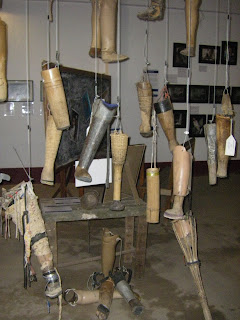On Saturday, I went to the COPE visitors’ center. I’d been there a couple times for events and know a fair bit about the organization, but I’d never actually looked at all the displays. The COPE visitors’ center is located on the grounds of the National Rehabilitation Center (NRC) and COPE (Cooperative Orthotic and Prosthetic Enterprise http://www.copelaos.org ) assists in many of the NRCs efforts, including providing financial support for orthotics and other services for patients unable to pay. You may remember me mentioning COPE before, because they were one of the beneficiaries of the fundraising efforts for the Team Dai cycling challenge.
Even after living in Laos for two years and reading about the secret war and the legacies of this war, the displays are still confronting. They are well assembled and informative and the use of the personal stories of the victims makes it very powerful. Regardless of your stand on the cluster bomb ban, the work of this organization is impressive. I encourage anyone visiting Vientiane to stop by the visitors’ center and support this amazing group
After seeing Colin Cotterill’s art adorning the COPE visitors’ center, I headed to JOMA to enjoy a taco salad and the last pages of the latest Dr. Siri mystery, Love Songs From a Shallow Grave. With the whodunit solved, I then headed to the Lao National Museum. I’ve passed it numerous times in the last two years, but had never taken the time to stop. It was quite a fascinating experience. There were some interesting displays about the ancient Kingdoms, but after visiting Wat Phu in Champasack, I felt I’d already covered that information. Much more fascinating were the upstairs displays about Laos from the colonial era to modern times. If one had any doubt about how the government feels about French colonialism and the Americans, this museum would make it perfectly clear. In photo after photo, brave Lao men fight off these forces, eventually sending them away in defeat. I was impressed by the quality of the available English translations, but unfortunately there were few translations for many of the best bits, especially in the anti-American imperialism section. I can’t say the museum presented a different view of this period than American museums, because I’ve never been to an American museum that even talks about this period of history. However, should I someday visit such a museum on the other side of the globe, I’m sure there would be a different slant to the story. I think every American should travel and get a taste how the rest of the world views our nation. It is an eye-opening experience.

Lao cultural center as viewed from the Lao National Museum


No comments:
Post a Comment